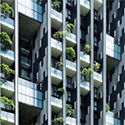Filter by
You must be a CTBUH Member to view this resource.

Oasia Hotel Downtown
Building
Completed
2016
Hotel
All-Concrete
190.9 m / 626 ft
27
314
64
13
19,416 m² / 208,992 ft²
You must be a CTBUH Member to view this resource.
You must be a CTBUH Member to view this resource.
Proposed
Construction Start
Completed
Usually involved in the front end design, with a "typical" condition being that of a leadership role through either Schematic Design or Design Development, and then a monitoring role through the CD and CA phases.
The Design Engineer is usually involved in the front end design, typically taking the leadership role in the Schematic Design and Design Development, and then a monitoring role through the CD and CA phases.
Other Consultant refers to other organizations which provided significant consultation services for a building project (e.g. wind consultants, environmental consultants, fire and life safety consultants, etc).
Material Supplier refers to organizations which supplied significant systems/materials for a building project (e.g. elevator suppliers, facade suppliers, etc).
You must be a CTBUH Member to view this resource.
Usually involved in the front end design, with a "typical" condition being that of a leadership role through either Schematic Design or Design Development, and then a monitoring role through the CD and CA phases.
The Design Engineer is usually involved in the front end design, typically taking the leadership role in the Schematic Design and Design Development, and then a monitoring role through the CD and CA phases.
The Design Engineer is usually involved in the front end design, typically taking the leadership role in the Schematic Design and Design Development, and then a monitoring role through the CD and CA phases.
The main contractor is the supervisory contractor of all construction work on a project, management of sub-contractors and vendors, etc. May be referred to as "Construction Manager," however, for consistency CTBUH uses the term "Main Contractor" exclusively.
Other Consultant refers to other organizations which provided significant consultation services for a building project (e.g. wind consultants, environmental consultants, fire and life safety consultants, etc).
Material Supplier refers to organizations which supplied significant systems/materials for a building project (e.g. elevator suppliers, facade suppliers, etc).
2018 CTBUH Awards
2018 CTBUH Awards
2018 CTBUH Awards
4 June 2018 - CTBUH News
19 December 2016 - CTBUH News

31 May 2018 | Singapore
Envisaged as a “tropical tower” in the concrete jungle, the Oasia Hotel Downtown incorporates lush greenery on its façade and terraces. The tower is like...

22 December 2023
Katarzyna Wodzisz
Incorporating greenery in skyscrapers prompts sustainability debates. This study questions the assumption that green features ensure sustainability, as designers often adopt them carelessly, leading to...

31 May 2018 | Singapore
Envisaged as a “tropical tower” in the concrete jungle, the Oasia Hotel Downtown incorporates lush greenery on its façade and terraces. The tower is like...

31 May 2018 | Singapore
A tower of green and red in the heart of Singapore’s dense Central Business District, the Oasia Hotel Downtown is a prototype of land-use intensification...

17 October 2016 | Singapore
Mun Summ Wong of WOHA Architects is interviewed by Chris Bentley during the 2016 CTBUH China Conference. Mun Summ discusses the garden city concept with...

17 October 2016 | Singapore
This presentation proposes an alternative to the continuing implementation of unsustainable 20th century urban planning models. By using WOHA’s mini-city projects and proposals as prototypes...

18 September 2014 | Singapore
Asia’s rapidly growing metropolises demand an alternative strategy for city planning and architecture that addresses the need to live appropriately and sustainability with our tropical...

22 December 2023
Katarzyna Wodzisz
Incorporating greenery in skyscrapers prompts sustainability debates. This study questions the assumption that green features ensure sustainability, as designers often adopt them carelessly, leading to...

05 July 2023
Roberta dal Molin, Shenav Ragiv, &Elena Giacomello
Skyscrapers commonly rise in major cities worldwide, but the difference is in how they are integrated into the urban plan. This paper provides a comprehSkyscrapers...

28 July 2018
Mun Summ Wong, Richard Hassell & Hong Wei Phua, WOHA Architects
Oasia Hotel Downtown is a prototype of land use intensification in the tropics. Unlike the sleek and sealed skyscrapers that evolved in the temperate West,...
4 June 2018
The CTBUH Awards Jury has named Oasia Hotel Downtown the "Best Tall Building Worldwide", in addition to recognizing nine other award winners.
Subscribe below to receive periodic updates from CTBUH on the latest Tall Building and Urban news and CTBUH initiatives, including our monthly newsletter. Fields with a red asterisk (*) next to them are required.
View our privacy policy